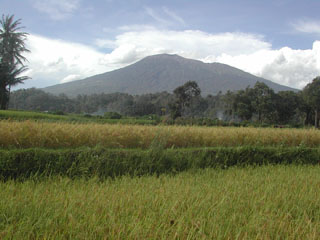Report on Marapi (Indonesia) — 3 January-9 January 2024
Smithsonian Institution / US Geological Survey
Weekly Volcanic Activity Report, 3 January-9 January 2024
Managing Editor: Sally Sennert.
Please cite this report as:
Global Volcanism Program, 2024. Report on Marapi (Indonesia) (Sennert, S, ed.). Weekly Volcanic Activity Report, 3 January-9 January 2024. Smithsonian Institution and US Geological Survey.
Marapi
Indonesia
0.38°S, 100.474°E; summit elev. 2885 m
All times are local (unless otherwise noted)
PVMBG reported that eruptive activity at Marapi (on Sumatra) was ongoing at Verbeek Crater during 3-9 January. White plumes rose 300-350 m above the summit and drifted S and SW on 4 January. White-and-gray ash plumes rose 150-600 m above the summit and drifted S, SW, N, and NE during 5-8 January.
PVMBG reevaluated instrumental data and visual observations at Marapi and concluded that activity was continuing at high levels; at 1800 on 9 January they raised the Alert Level to 3 (on a scale of 1-4) and warned the public to stay 4.5 km away from Verbeek Crater. They noted that ongoing high seismicity and increasing numbers of low-frequency and deep volcanic earthquakes indicated that magma continued to be supplied at depth. Incandescence at the crater and the ejection of incandescent material after the 3 December eruption indicated that the eruption style had change from phreatic to magmatic; sulfur dioxide emissions measured from satellite were at high levels.
Geological Summary. Gunung Marapi, not to be confused with the better-known Merapi volcano on Java, is Sumatra's most active volcano. This massive complex stratovolcano rises 2,000 m above the Bukittinggi Plain in the Padang Highlands. A broad summit contains multiple partially overlapping summit craters constructed within the small 1.4-km-wide Bancah caldera. The summit craters are located along an ENE-WSW line, with volcanism migrating to the west. More than 50 eruptions, typically consisting of small-to-moderate explosive activity, have been recorded since the end of the 18th century; no lava flows outside the summit craters have been reported in historical time.
Source: Pusat Vulkanologi dan Mitigasi Bencana Geologi (PVMBG, also known as CVGHM)

